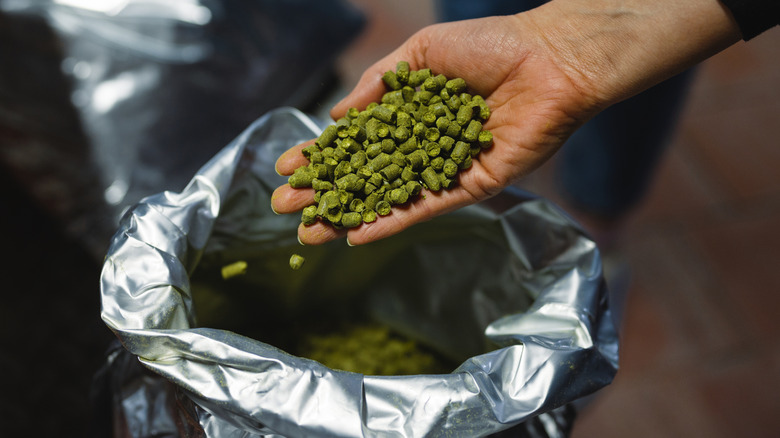What Do The Letters 'DDH' Mean When It Comes To Beer?
Over just a few decades, craft beer transformed from a fringe product crafted at microbreweries to a multi-billion dollar industry. And the innovative style that's long led the movement is the India Pale Ale, or IPA. From the IPA's 18th century origins, the bold and hop-heavy style first introduced American craft drinkers to the aromatic potential of brew. Since then, innovation in brewing techniques and hop integration have evolved the beer into a large array of substyles. So when you're making a selection among all the IPAs on the store shelf, you'll want to familiarize yourself with beer's descriptors to find the can for you.
An especially common acronym often found on labels and tap lists is "DDH." Short for double dry hopping, the technique employs a large amount of hops added late into the beer creation process. Conducted once the beer's been chilled, the move imparts a large dose of the complex fruity, floral, spiced, and earthy flavors found in hops. Yet best of all, there's not a drastic increase in bitterness, since heat during brewing is necessary to raise a beer's bitter flavors (measured as International Bitterness Units, or IBU). With the enormous potential of integrated hops, the technique allows for combining varieties in intricate ways, crafting IPAs that burst with flavor.
DDH adds two doses of hops after fermentation
Although commonly employed in the brewing industry, double dry hopping doesn't come with a precise definition. The name emerged to describe the technique of employing two rounds of dry-hopping, hence the double moniker. However, modern brewers have also found success in integrating the entire batch at once, or adding and then replacing hops; Every beer maker employs their own process. What's universal is the addition of a large hop volume, so expect a flavorful beer.
Unsurprisingly, the technique is most strongly interlinked with IPAs, especially of the hazy variety. All those hop particles tossed into the brew aren't filtered out, and are instead promoted for their aroma. Most often, DDH is employed while making New England IPAs, creating thick-textured beers which focus on the fruity notes of hops.
Nevertheless, brewers also craft more bitter West Coast IPAs with the method. And while pale ales are different from IPAs by way of a less hop-heavy palate, brewers even use DDH for this IPA-adjacent beer style, too. Such is the intriguing creative canvas of beer-making; The possibilities are wide-ranging. So try out all the offerings available, swinging by the best breweries in the U.S. to taste DDH done right.

